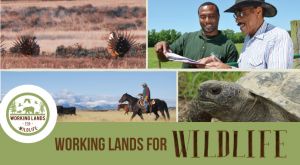NRCS Working Lands for Wildlife
Through Working Lands for Wildlife (WLFW), USDA uses a win-win approach to systematically target conservation efforts to improve agricultural and forest productivity which enhance wildlife habitat on working landscapes. Target species are used as barometers for success because their habitat needs are representative of healthy, functioning ecosystems where conservation efforts benefit a much broader suite of species.
Through the Farm Bill, NRCS provides technical and financial assistance to participants who voluntarily make improvements to their working lands while the US Fish and Wildlife Service (FWS) provides participants with regulatory predictability for the Endangered Species Act (ESA). This innovative approach empowers landowners with a means to make on-the-ground improvements and provides peace of mind that no matter the legal status of a species, they can keep their working lands working.
This model has proven extremely popular with private landowners across the United States. To date, WLFW has helped producers conserve more than 7.1 million acres of wildlife habitat and has helped many species such as the greater sage-grouse in the West and the New England cottontail in the Northeast. For both of these species — in large part because of voluntary conservation efforts on private lands — the FWS determined listing under ESA was not warranted. Beginning in 2017, NRCS expanded this model and now includes 19 landscapes covering 48 States.

